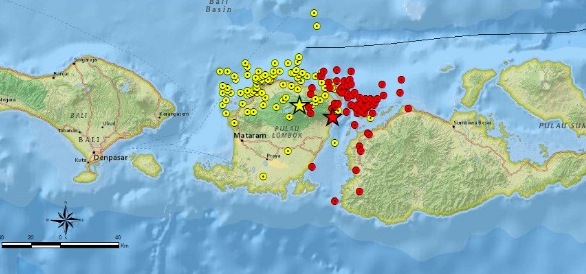A 6.9 earthquake that rattled Lombok on Sunday evening is evidence of new earthquake activity and is not an aftershock of the big 7.0 earthquake that struck the Indonesian island on August 5, according to Indonesia’s Meteorology, Climatology, and Geophysics Agency (BMKG).
The 6.9 earthquake that hit at 9:56pm and dozens of aftershocks that have followed are not a continuation of the previous earthquake, Daryono, BMKG head of earthquake information and early tsunami warning, told Kompas.
However, the earthquakes are caused by the same source, the Flores Back Arc Thrust, according to Daryono.
The 6.9 earthquake we’re talking about here is not to be confused with an initial reading of 7.0 on the scale, says National Disaster Mitigation Agency (BNPB) spokesman Sutopo Purwo Nugroho.
BMKG melaporkan gempa 6,9 SR (bukan 7 SR) yg terjadi pada 19/8/2018 pukul 21.56 WIB adalah AKTIVITAS GEMPA BARU. Bukan gempa susulan dari gempa 7 SR (5/8/2018). Sumber gempa dari Sesar Naik Flores. Intensitas guncangan gempa dirasakan di Lombok Timur & Lombok Utara VI-VII MMI. pic.twitter.com/4egFkhk5W0
— Sutopo Purwo Nugroho (@Sutopo_PN) August 19, 2018
Different segments have been at play, says Geotechnology Research Center of the Indonesian Institute of Sciences (LIPI) researcher Danny Hilman Natawidjaja.
“The first three large earthquakes, the 6.4, 7.0, and 6.5 were in the middle segment. The (6.9 on Sunday) was in the eastern segment, triggered by the middle segment,” Natawidjaja told Okezone.
In other words, the first set of earthquakes triggered earthquakes in an adjacent area.
For instance, when the earthquake struck Aceh in Indonesia’s Sumatra in 2004, earthquakes were triggered in other areas such as Nias, Bengkulu, and the Mentawais, according to the researcher.
“So it’s the same thing. Only the scale (between the Sumatra and Lombok earthquakes) is different,” he added.
The death count from the earthquakes starting from August 6 is already up to 506 people and continues to climb.
In addition, it’s estimated that 431,416 people have been displaced, 74,361 housing units have been damaged, and damage and losses are believed to total in the ballpark of IDR7.7 trillion (US$528 million).




